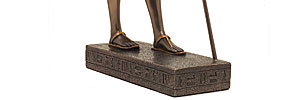From the earliest periods of Ancient Egyptian history, all Egyptians were buried with burial goods, which were thought to be necessary in the afterlife. These usually consisted of useful everyday objects (bowls, combs, trinkets) and food. Wealthier Egyptians could afford to be buried with jewelry, furniture, and valuables - often making them targets of tomb robbers.
As burial customs developed, wealthy citizens were buried in wooden coffins and accompanied by a variety of different valuables. Wooden models, which depicted the everyday activities that the deceased expected to continue doing in the afterlife, became a very popular burial item. A rectangular-shaped coffin became standard, which was often brightly painted and decorated.
Egyptian burial customs changed over time. In the New Kingdom, a coffin in the shape of a human body became standardized. The deceased were often buried with shabti statues, which were believed to perform work for them in the afterlife. In later burials, the amount of included shabti statues increased - often numbering in the hundreds. In addition, many other types of magical figurines were included, to offer protection. Although burial goods changed throughout Egyptian history, they always served to protect the deceased and provide sustenance in the afterlife.
Cold Cast is a modern method of casting sculptures using a mixture of resin and powdered polymer materials. The finished sculpture has a surface which looks very similar to traditionally cast material, but tends to be much lighter.

















